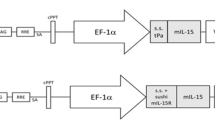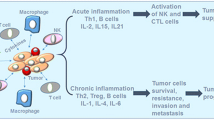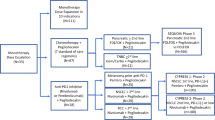Abstract
A role for interleukin-6 (IL-6) in malignant mesothelioma has been suggested by the clinically presenting symptoms of mesothelioma patients, which include fever, weight loss and thrombocytosis. A murine model of malignant mesothelioma was therefore used to examine the potential role of IL-6 in this cancer type and whether the effect of interferon α (IFNα) therapy on mesothelioma might be mediated, in part, by regulating IL-6 levels and/or IL-6-induced pathobiology. A panel of human and murine mesothelioma cell lines was assayed for endogenous IL-6 production in a bioassay, and for IL-6-mRNA expression. Four out of 5 human and 5 out of 15 murine mesothelioma cell lines produced moderate to high levels of bioactive IL-6 in vitro. This result was corroborated by mRNA detection. One of the representative murine cell lines, AB22, was chosen for further in vivo studies in the murine mesothelioma model. In AB22-inoculated mice detectable serum IL-6 levels were found to precede macroscopically detectable tumour growth, clinical signs (cachexia, abdominal distension, diarrhoea) and changes in the peripheral lymphoid organs (cell depletion and functional depression). Treatment with anti-IL-6 antibody curtailed the clinical symptoms (P<0.001), as did treatment with recombinant human (rhu) IFNα (P<0.001). Neither anti-IL-6 antibody nor rhuIFNα had a direct growth-inhibitory effect on the AB22 mesothelioma cell line in vitro, however, in vivo rhuIFNα treatment of mice inoculated with AB22 cells attenuated both IL-6 mRNA expression in the tumours and serum IL-6 levels, ameliorated the depression of lymphocyte activities, and enhanced the number of tumour-infiltrating lymphocytes and macrophages. On the basis of these results it is suggested that IL-6 mediates some of these effects, directly or indirectly, and that a combination therapy of rhuIFNα and anti-IL-6 antibody may be an improved palliative treatment for patients with malignant mesothelioma.
Similar content being viewed by others
References
Bielefeldt-Ohmann H, Sabara M, Lawman MJP, Griebel P, Babiuk LA (1988) A monoclonal antibody detects a macrophage maturation antigen which appears independently of class II antigen expression: reactivity of monoclonal EBM11 with bovine macrophages. J Immunol 140:2201
Bielefeldt-Ohmann H, Fitzpatrick DR, Marzo AL, Jarnicki AG, Himbeck RP, Davis MR, Manning LS, Robinson BWS (1994) Patho- and immunobiology of malignant mesothelioma: characterisation of tumour infiltrating leukocytes and cytokine production in a murine model. Cancer Immunol Immunother 39:347
Bielefeldt-Ohmann H, Fitzpatrick DR, Marzo AL, Jarnicki AG, Musk AW, Robinson BWS (1995) The potential for interferon-α based therapy in mesothelioma: assessment in a murine model. J Interferon Cytokine Res 15:213
Burger R, Gramatzki M (1993) Responsiveness of the interleukin (IL)-6-dependent cell line B9 to IL-11. J Immunol Methods 158:147
Chahinian AP, Pajak TF, Holland JF, Norton L, Ambinder RM, Mandel EM (1982) Diffuse malignant mesothelioma, prospective evaluation of 69 patients. Ann Intern Med 69:356
Davis MR, Manning LS, Whitaker D, Garlepp MJ, Robinson BWS (1992) Establishment of a murine model of malignant mesothelioma. Int J Cancer 52:881
De Mayer E, De Mayer-Guignard J (1988) In: Interferons and other regulatory cytokines. Wiley, New York, p 3
Ferrari M, Fornasiero MC, Isetta AM (1990) MTT colorimetric assay for testing macrophage cytotoxic activity in vitro. J Immunol Methods 131:165
Fitzpatrick DR, Wie J, Webb D, Bonfiglioli R, Gardner ID, Mathews JD, Bielefeldt-Ohmann H (1991) Preferential binding ofChlamydia trachomatis to subsets of human lymphocytes and induction of interleukin-6 and interferon-gamma. Immunol Cell Biol 69:337
Fitzpatrick DR, Bielefedt-Ohmann H, Himbeck RP, Jarnicki AG, Marzo AL, Robinson BWS (1994) Transforming growth factor-beta: antisense RNA-mediated inhibition affects anchorage-independent growth tumorigenicity and T-cell infiltration in malignant mesothelioma. Growth Factor 11:29
Gelin J, Moldawer LL, Lönnroth C, Sherry B, Chizzonite R, Lundholm K (1991) Role of endogenous tumor necrosis factor α and interleukin 1 for experimental tumor growth and the development of cancer cachexia. Cancer Res 51:415
Hill RJ, Warren K, Levin J (1990) Stimulation of thrombopoiesis in mice by human recombinant interleukin 6 J Clin Invest 85:1242
Ishibashi T, Kimura H, Shikama Y, Uchida T, Kariyone S, Hirano T, Kishimoto T, Takatsuki F, Akiyama Y (1989) Interleukin-6 is a potent thrombopoietic factor in vivo in mice. Blood 74:1241
King LB, Ashwell JD (1993) Signaling for death of lymphoid cells. Curr Opin Immunol 5:368
Klein B, Wijdenes J, Zhang X-G, Jourdan M, Boiron J-M, Brochier J, Liautard J, Merlin M, Clement C, Morel-Fournier B, Lu Z-Y, Mannoni P, Sany J, Bataille R (1991) Murine anti-interleukin-6 monoclonal antibody therapy for a patient with plasma cell leukemia. Blood 78:1198
Kriegler M (1990) Gene transfer and expression. A laboratory manual, pp 181–183. New York: Stockton Press
Kurzrock R, Redman J, Cabanillas F, Jones D, Rothberg J, Talpaz M (1993) Serum interleukin 6 levels are elevated in lymphoma patients and correlate with survival in advanced Hodgkin's disease and with B symptoms. Cancer Res 53:2118
Lu C, Kerbel RS (1993) Interleukin-6 undergoes transition from paracrine growth inhibitor to autocrine stimulator during human melanoma progression. J Cell Biol 120:1281
Lu C, Vickers MF, Kerbel RS (1992) Interleukin-6: a fibroblast-derived growth inhibitor of human melanoma cells from early advanced stages of tumor progression. Proc Natl Acad Sci USA 89:9215
Manning LS, Whitaker D, Murch AR, Garlepp MJ, Davis MR, Musk AW, Robinson BWS (1992) Establishment and characterization of five human malignant mesothelioma cell lines derived from pleural effusions. Int J Cancer 47:285
McCormack JE, Callahan JE, Kappler J, Marrack PC (1993) Profound deletion of mature T cells in vivo by chronic exposure to exogenous superantigens. J Immunol 150:3785
Motro B, Itin A, Sachs L, Keshet E (1990) Pattern of interleukin 6 gene expression in vivo suggests a role for this cytokine in angiogenesis. Proc Natl Acad Sci USA 87:3092
Musk AW, Christmas TI (1992) The clinical diagnosis of malignant mesothelioma. In: Henderson DW, Shilkin KB, Langlois SLP, Whitaker D (eds) Malignant mesothelioma. Hemisphere, New York, pp 253–258
Musk AW, Bowman RV, Christmas TI, Robinson BWS (1992) Management of malignant mesothelioma. In: Henderson DW, Shilkin KB, Langlois SLP, Whitaker D (eds) Malignant mesothelioma. Hemisphere, New York, pp 292–302
Ohe Y, Podack ER, Olsen KJ, Miyahara Y, Miura K, Saito H, Koishihara Y, Ohsugi Y, Ohira T, Nishio K, Saijo N (1993) Interleukin-6 cDNA transfected Lewis lung carcinoma cells show unaltered net tumour growth rate but cause weight loss and shorten survival in syngeneic mice. Br J Cancer 67:939
Oldenburg HSA, Rogy MA, Lazarus DD, Van Zee KJ, Keeler BP, Chizzonite RA, Lowry SF, Moldawer LL (1993) Cachexia and the acute-phase protein response in inflammation are regulated by interleukin-6. Eur J Immunol 23:1889
Oliff A (1988) The role of tumor necrosis factor (cachectin) in cachexia. Cell 54:141
Pabst R, Binns RM (1989) Heterogeneity of lymphocyte homing physiology. Several mechanisms operate in the control of migration to lymphoid and non-lymphoid organs in vivo. Immunol Rev 108:83
Quesada JR, Talpaz M, Rios A, Kurzrock R, Gutterman JU (1986) Clinical toxicity of interferon in cancers. J Clin Oncol 4:234
Schmitter D, Lauber B, Fagg B, Stahel RA (1992) Hematopoietic growth factors secreted by seven human pleural mesothelioma cell lines: interleukin-6 production as a common feature. Int J Cancer 51:296
Snick J van (1990) Interleukin-6: an overview. Annu Rev Immunol 8:253
Spiegelman BM, Hotamisligil GS (1993) Through thick and thin: wasting, obesity, and TNFα. Cell 73:625
Strassman G, Fong M, Kenney JS, Jacob CO (1992) Evidence for the involvement of IL-6 in experimental cancer cachexia. J Clin Invest 89:1681
Strassman G, Jacob CO, Evans R, Beall D, Fong M (1992) Mechanisms of experimental cancer cachexia. Interaction between mononuclear phagocytes and colon-26 carcinoma and its relevance to IL-6-mediated cancer cachexia. J Immunol 148:3674
Suzuki H, Yasukawa K, Saito T, Goitsuka R, Hasegawa A, Ohsugi Y, Taga T, Kishimoto T (1993) Anti-human interleukin-6 receptor antibody inhibits human myeloma growth in vivo. Eur J Immunol 22:1989
Upham J, Musk AW, Van Hazel G, Byrne M, Robinson BWS (1993) Interferon alpha and Doxorubicin in malignant mesothelioma, a phase II study. Aust NZ J Med 23:683
Utsumi K, Takai Y, Tada T, Ohzeki S, Fujiwara H, Hamaoka T (1990) Enhanced production of IL-6 in tumor-bearing mice and determination of cells responsible for its augmented production. J Immunol 145:397
Wang R, Murphy KM, Loh DY, Weawer C, Russell JH (1993) Differential activation of antigen-stimulated suicide and cytokine production pathways in CD4+ T cells is regulated by the antigen-presenting cell. J Immunol 150:3832
Author information
Authors and Affiliations
Rights and permissions
About this article
Cite this article
Bielefeldt-Ohmann, H., Marzo, A.L., Himbeck, R.P. et al. Interleukin-6 involvement in mesothelioma pathobiology: inhibition by interferon α immunotherapy. Cancer Immunol Immunother 40, 241–250 (1995). https://doi.org/10.1007/BF01519898
Received:
Accepted:
Issue Date:
DOI: https://doi.org/10.1007/BF01519898




